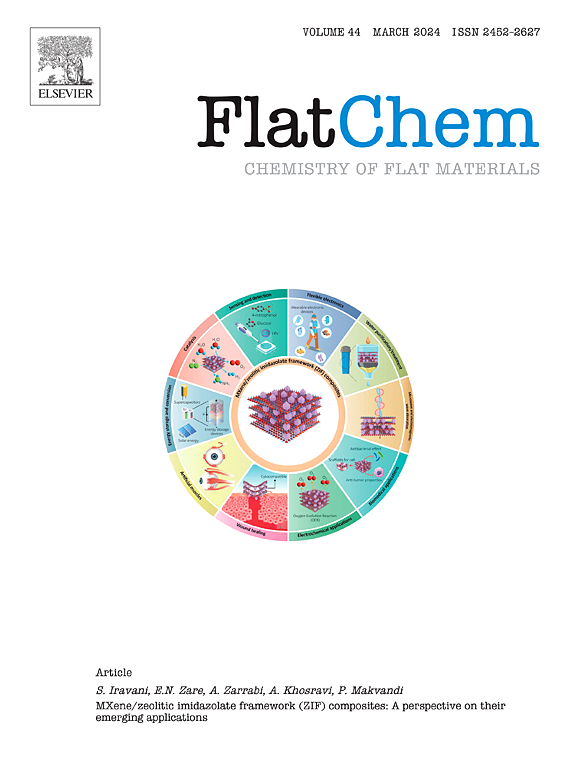新型六亚胺-苯二胺共价有机骨架-金属氧化物复合材料超级电容器电极材料的设计
IF 5.9
3区 材料科学
Q2 CHEMISTRY, PHYSICAL
引用次数: 0
摘要
共价有机框架(COF)材料自2005年问世以来,除了在电池和超级电容器等储能系统中应用外,还广泛应用于环境修复、光催化剂、电催化以及提高热稳定性和机械稳定性的集成设备等各个领域。在这项工作中,我们报告了易于合成,低成本,化学稳定的胺基COF/金属氧化物复合材料作为高性能超级电容器(SC)电极。采用一步水热法快速合成了HPd -苯二胺(HPd) COF及HPd/MoO2、HPd/NiO和HPd/ZnO三种COF/金属氧化物复合材料。采用粉末x射线衍射(XRD)、傅里叶红外光谱(FTIR)和场发射扫描电镜(FESEM)等初步表征技术,成功合成了COF/金属氧化物复合材料。电化学研究发现,当电流密度为0.5 A/g时,HPd/MoO2、HPd/NiO和HPd/ZnO的比容分别为181.1、177.4和394.3 F/g。在0.5 A/g下,HPd/ZnO的比能最高,为39.43 Wh/kg。本研究为设计新型碳纳米管复合材料作为超导电极材料提供了有效的前景。本文章由计算机程序翻译,如有差异,请以英文原文为准。

Designing of novel hexamine-phenylenediamine covalent organic framework - metal oxide composites as electrode materials for supercapacitors
Covalent organic framework (COF) materials since their inception in 2005 have seen extensive applications in various fields including environmental remediation, photo-catalysts, electrocatalysis and in integrated devices to improve thermal and mechanical stability besides their application in energy storage systems such as batteries and supercapacitors. In this work, we report easily synthesizable, low-cost, chemically stable amine-based COF/metal oxide composites to function as high-performance supercapacitor (SC) electrodes. A one-step hydrothermal method has been used for the facile synthesis of Hexamine-phenylenediamine (HPd) COF and three COF/metal oxide composites- HPd/MoO2, HPd/NiO, and HPd/ZnO, respectively. Initial characterization techniques employed included powder X-ray diffraction (XRD), Fourier transform infrared spectroscopy (FTIR), and Field-emission scanning electron microscopy (FESEM), which show successful synthesis of the COF/metal oxide composites. The electrochemical investigation found the specific capacitances to be 181.1, 177.4, and 394.3 F/g for HPd/MoO2, HPd/NiO, and HPd/ZnO, respectively, at the current density of 0.5 A/g. The specific energy was found to be highest in the case of HPd/ZnO at 39.43 Wh/kg at 0.5 A/g. The work presents effective prospects for designing novel COF composites as electrode materials for SC applications.
求助全文
通过发布文献求助,成功后即可免费获取论文全文。
去求助
来源期刊

FlatChem
Multiple-
CiteScore
8.40
自引率
6.50%
发文量
104
审稿时长
26 days
期刊介绍:
FlatChem - Chemistry of Flat Materials, a new voice in the community, publishes original and significant, cutting-edge research related to the chemistry of graphene and related 2D & layered materials. The overall aim of the journal is to combine the chemistry and applications of these materials, where the submission of communications, full papers, and concepts should contain chemistry in a materials context, which can be both experimental and/or theoretical. In addition to original research articles, FlatChem also offers reviews, minireviews, highlights and perspectives on the future of this research area with the scientific leaders in fields related to Flat Materials. Topics of interest include, but are not limited to, the following: -Design, synthesis, applications and investigation of graphene, graphene related materials and other 2D & layered materials (for example Silicene, Germanene, Phosphorene, MXenes, Boron nitride, Transition metal dichalcogenides) -Characterization of these materials using all forms of spectroscopy and microscopy techniques -Chemical modification or functionalization and dispersion of these materials, as well as interactions with other materials -Exploring the surface chemistry of these materials for applications in: Sensors or detectors in electrochemical/Lab on a Chip devices, Composite materials, Membranes, Environment technology, Catalysis for energy storage and conversion (for example fuel cells, supercapacitors, batteries, hydrogen storage), Biomedical technology (drug delivery, biosensing, bioimaging)
 求助内容:
求助内容: 应助结果提醒方式:
应助结果提醒方式:


